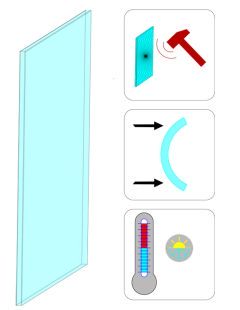Toughened Glass – ESG
In the process of production of toughened glass, glass is heated to temperature exceeding 600˚C, and then rapidly cooled down. Such a treatment allows to produce glass that meets requirements of PN-EN 12150 and features properties that are significantly better compared to annealed glass.
Advantages of toughened glass include:
- improved mechanical resistance, including bending and impact resistance,
- improved resistance to thermal shocks, including resistance to temperature differences present within a single glass pane,
- safety in case of breakage (toughened glass breaks into very small pieces).
TOUGHENED GLASS with heat-soak test
Microscopic particles of nickel sulphide (NiS) are sometimes unavoidably mixed-in with the sand used in manufacturing the glass. As a result of tempering and change of glass temperature, nickel sulphide may cause spontaneous breakage of glass. Despite the fact that this happens very rarely, in certain cases it is recommended to apply treatment that minimises the possibility of occurrence of such breakages.
Occurrence of nickel sulphide crystals in a finished glass product is minimised using so-called heat soak test (HST), according to PN-EN 14179.
| PROCESS | GLASS THICKNESS | MINIMUM DIMENSION | MAXIMUM DIMENSION |
|---|---|---|---|
| Tempering | 4 to 19 mm | 80 X 275 mm | 3210 X 7000 mm |
| HST test | 4 to 19 mm | No limit | 3210 X 7000 mm |
Toughened Glass
